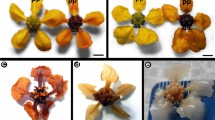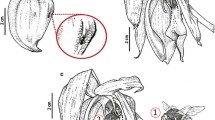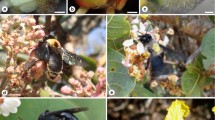Abstract
Many Velloziaceae flowers present conspicuous glands, whose taxonomic value has already been highlighted. However, until now, their micromorphology, anatomy and ultrastructure have not been investigated, nor have the natures and possible functions of their exudates. Our aim was to investigate distribution, ontogenesis, structure, and secretion mechanisms of glands of Barbacenia flava and Vellozia intermedia and to discuss their possible ecological functions. Samples were prepared according to standard methods for investigations of plant anatomy, scanning electron microscopy, and transmission electron microscopy. Histochemical tests were performed, and focal field observations were made in the study site. The capitate stalked glands on the pedicel, tepals and hypanthium are covered by a sticky secretion that is released in the gland head through the outer periclinal cell walls and cuticle. Secretions are produced in the epidermal and subepidermal cells that contain structural components typical of mixed, mainly lipophilic secretions. Bacteria were found inside the oil-resin gland cells of both species. The Meliponina bees Trigona spinipes and Tetragonisca angustula were observed collecting resin from both species, but were not involved in pollination. Our observations clearly indicate that flower glands of B. flava and V. intermedia are oil-resin secreting and remain active in secretion from very young buds, through to immature fruit. New, smaller glands replace senescent glands by divisions near the base of the original stalk cells. Oil-resin glands have a number of different, but important functions, including the interaction with Meliponina bees, protection against water loss and high temperatures by ultraviolet screening, and anti-desiccant properties.







Similar content being viewed by others
References
Altenburger R, Matile P (1990) Further observations on rhythmic emission of fragrance in flowers. Planta 180:194–197
Alves RJV, Silva NG, Oliveira JA, Medeiros D (2014a) Circumscribing campo rupestre—megadiverse Brazilian rocky montane savannas. Braz J Biol 74:355–362
Alves RJV, Guimarães AR, Rezende CM, Braga LS, Silva NGA (2014b) New giant Vellozia (Velloziaceae) from Minas Gerais, Brazil with comments on the V. compacta complex and conservation. Phytotaxa 172:13–21
Amaral LIV, Pereira MF, Cortelazzo AL (2001) Formação das substâncias de reserva durante o desenvolvimento de sementes de urucum (Bixa orellana L.—Bixaceae). Acta Bot Brasil 15:125–132
Armbruster WS (1984) The role of resin in angiosperm pollination: ecological and chemical considerations. Amer J Bot 71:1149–1160
Armbruster WS, Webster GL (1979) Pollination of two species of Dalechampia (Euphorbiaceae) in Mexico by euglossine bees. Biotropica 11:278–283
Ascensão L, Marques N, Pais MS (1997) Peltate glandular trichomes of Leonotis leonurus leaves: ultrastructure and histochemical characterization of secretions. Int J Pl Sci 158:249–258
Beltran-Garcia MJ, White JF Jr, Prado FM, Prieto KR, Yamaguchi LF, Torres MS, Di Mascio P (2014) Nitrogen acquisition in Agave tequilana from degradation of endophytic bacteria. Sci Rep 4:6938. doi:10.1038/srep06938
Cheniclet C, Carde JP (1985) Presence of leucoplasts in secretory cells and of monoterpenes in the essential oil: a correlative study. Israel J Bot 34:219–238
Cortelazzo AL, Vidal BC (1991) Soybean seed proteins: detection in situ and mobilization during germination. Braz J Bot 14:27–34
Dafni A, Keavan PG, Husband BC (2005) Practical pollination biology. Enviroquest Ltda, Cambridge
Dell B (1977) Distribution and function of resins and glandular hairs in Western Australian plants. J Roy Soc Western Australia 59:119–123
Dell B, McComb AJ (1987) Plant resins—their formation, secretion and possible functions. Advances Bot Res 6:277–316
Evert RF (2006) Esau’s plant anatomy: meristems, cells, and tissues of the plant body: their structure, function, and development, 3rd edn. Wiley, Hoboken
Fahn A (1979) Secretory tissues in plants. Academic Press, London
Fahn A (1988) Secretory tissues in vascular plants. New Phytol 108:229–257
Fahn A (2000) Structure and function of secretory cells. Advances Bot Res 31:37–75
Feder N, O’Brien TP (1968) Plant microtechnique: some principles and new methods. Amer J Bot 55:123–142
Feeny P (1976) Plant apparency and chemical defense. In: Wallace JW, Mansell RL (eds) Biochemical interaction between plants and insects. Recent advances in phytochemistry, vol 10. Plenum Press, New York, pp 1–40. doi:10.1007/978-1-4684-2646-5_1
Gabe M (1968) Techniques histologiques. Masson & Cie, Paris
Gahan PB (1984) Plant histochemistry and cytochemistry—an introduction. Academic Press, London
Giulietti AM, Pirani JR (1988) Patterns of geographic distribution of some plant species from the Espinhaço Range, Minas Gerais and Bahia, Brazil. In: Vanzolini PE, Heyer WR (eds) Proceedings of a Workshop on Neotropical Distribution Patterns. Academia Brasileira de Ciências, Rio de Janeiro, pp 39–69
Gleizes M, Marpeau A, Pauly G, Bernard-Dagan C (1982) Role of acyclic compounds in monoterpene biosynthesis in Pinus pinaster. Phytochemistry 21:2641–2644
Gleizes M, Pauly G, Carde JP, Marpeau A, Bernard-Dagan C (1983) Monoterpene hydrocarbon biosynthesis by isolated leucoplasts of Citrofortunella mitis. Planta 159:373–381
Gregory M, Baas P (1989) A survey of mucilage cells in vegetative organs of the dicotyledons. Israel J Bot 38:125–174
Hammond CT, Mahlberg PG (1973) Morphology of glandular hairs of Cannabis sativa from scanning electron microscopy. Amer J Bot 60:524–528
Hansted L, Jakobsen HB, Olsen CE (1994) Influence of temperature on the rhythmic emission of volatiles from Ribes nigrum flowers in situ. Pl Cell Environ 17:1069–1072
Harborne JB (1997) Biochemical plant ecology. In: Dey PM, Harborne JB (eds) Plant Biochemistry. Academic Press, London, pp 503–516
Jacobi CM, Del Sarto MCL (2007) Pollination of two species of Vellozia (Velloziaceae) from high-altitude quartzitic grasslands, Brazil. Acta Bot Brasil 21:325–333
Jakobsen HB, Olsen CE (1994) Influence of climatic factors on emission of flower volatiles in situ. Planta 192:365–371
Jensen WA (1962) Botanical histochemistry: principles and practice. WH Freeman & Co., San Francisco
Johansen DA (1940) Plant microtechnique. McGraw-Hill Book Company, New York
Kearns CA, Inouye DW (1993) Techniques for pollination biologists. University Press of Colorado, Niwot
Kleinig H (1989) The role of plastids in isoprenoid biosynthesis. Annual Rev. Pl Physiol Pl Molec Biol 40:39–59
Langenheim JH (2003) Plant resins: chemistry, evolution, ecology and ethnobotany. Timber Press, Portland
Langeron M (1949) Precis de microscopie. Masson & Cie, Paris
Loughrin JN, Hamilton-Kemp TR, Andersen RA, Hildebrand DF (1990) Volatiles from flowers of Nicotiana sylvestris, N. otophora and Malus domestica: headspace components and day/night changes in their relative concentrations. Phytochemistry 29:2473–2477
Machado SR, Gregório EA, Guimarães E (2006) Ovary peltate trichomes of Zeyheria montana (Bignoniaceae): developmental ultrastructure in relation to function. Ann Bot (Oxford) 97:357–369
Machado SR, Barreiro DP, Rocha JF, Rodrigues TM (2012) Dendroid colleters on vegetative and reproductive apices in Alibertia sessilis (Rubiaceae) differ in ultrastructure and secretion. Flora Morphol Distrib Funct Ecol Pl 207:868–877
Machado SR, Teixeira SP, Rodrigues TM (2014) Bacterial leaf glands in Styrax camporum (Styracaceae): first report for the family. Bot Int J Pl Biol 92:403–411
Machado SR, Paleari LM, Paiva EAS, Rodrigues TM (2015) Colleters on the inflorescence axis of Croton glandulosus (Euphorbiaceae): structural and functional characterization. Int J Pl Sci 176:86–93
Maclean RC, Ivemey-Cook WR (1952) Textbook of practical botany. Longmans Greenands Co., London
Majetic CJ, Raguso RA, Ashman TL (2009) The sweet smell of success: floral scent affects pollinator attraction and seed fitness in Hesperis matronalis. Funct Ecol 23:480–487
Matile P, Altenburger R (1988) Rhythms of fragrance emission in flowers. Planta 174:242–247
Mello-Silva R (1995) Aspectos Taxonômicos, Biogeográficos, Morfológicos e Biológicos das Velloziaceae de Grão-Mogol, Minas Gerais, Brasil. Bol Bot Univ São Paulo 14:49–79
Mello-Silva R (2004) Velloziaceae. In: Smith N, Mori SA, Henderson A, Stevenson DW, Heald SV (eds) Flowering plants of the neotropics. Princeton University Press, Princeton, pp 490–491
Mello-Silva R (2005) Morphological analysis, phylogenies and classification in Velloziaceae. Bot J Linn Soc 148:157–173
Menezes NL (1973) Natureza dos apêndices petalóides em Barbacenioideae (Velloziaceae). Bol Zool Biol Mar NS 30:713–755
Menezes NL (1980) Evolution in Velloziaceae, with special reference to androecial characters. In: Brickell CD, Cutler DF, Gregory M (eds) Petaloid monocotyledons. Linnean society symposium serries, vol 8. Academic Press, London, pp 117–139
Menezes NL (1988) Evolution of the anther in the family Velloziaceae. Bol Bot Univ São Paulo 10:33–41
Miller IM, Reporter M (1987) Bacterial leaf symbiosis in Dioscorea sansibarensis: morphology and ultrastructure of the acuminate leaf glands. Pl Cell Environ 10:413–424
Miller IM, Scott A, Gardner IC (1983) Leaf nodule development in Psychotria kirkii Hiern (Rubiaceae). Ann Bot (Oxford) 52:791–802
Miller IM, Gardner IC, Scott A (1984) Structure and function of trichomes in the shoot tip of Ardisia crispa (Thunb.) A.DC. (Myrsinaceae). Bot J Linn Soc 88:223–236
Montserrat L, Mello-Silva R (2013) Velloziaceae do Parque Estadual de Ibitipoca, Minas Gerais, Brasil. Bol Bot Univ São Paulo 31:131–139
Paiva EAS (2009) Ultrastructure and post-floral secretion of the pericarpial nectaries of Erythrina speciosa (Fabaceae). Ann Bot (Oxford) 104:937–944
Porto ALM, Machado SMF, Oliveira CMA, Bittrich V, Amaral MCA, Marsaioli AJ (2000) Polyisoprenylated benzophenones from Clusia floral resins. Phytochemistry 55:755–768
Possobom CCF, Guimarães E, Machado SR (2015) Structure and secretion mechanisms of floral glands in Diplopterys pubipetala (Malpighiaceae) a neotropical species. Flora Morphol Distrib Funct Ecol Pl 211:26–39
Reinhold-Hurek B, Hurek T (2011) Living inside plants: bacterial endophytes. Curr Opin Pl Biol 14:435–443
Renner S (1983) The widespread occurrence of anther destruction by Trigona bees in Melastomataceae. Biotropica 15:251–256
Reynolds ES (1963) The use of lead citrate at high pH as an electron-opaque stain in electron microscopy. J Cell Biol 17:208
Rodella LG, Tarifa JR (2002) Clima da Serra do Ibitipoca, MG. GEOUSP—Espaço e. Tempo 11:101–113
Rodrigues TM, Teixeira SP, Machado SR (2011) The oleoresin secretory system in seedlings and adult plants of copaíba (Copaifera langsdorffii Desf., Leguminosae–Caesalpinioideae). Flora Morphol Distrib Funct Ecol Pl 206:585–594
Rosenblueth M, Martínez-Romero E (2006) Bacterial endophytes and their interactions with hosts. Molec Pl Microbe Interact 19:827–837
Sá-Haiad B, Silva CP, Paula RCV, Rocha JF, Machado SR (2015) Androecia in two Clusia species: development, structure and resin secretion. Pl Biol (Stuttgart) 17:816–824
Sajo MG, Mello-Silva R, Rudall PJ (2010) Homologies of floral structures in Velloziaceae with particular reference to the corona. Int J Pl Sci 171:595–606
Sazima M (1978) Biologia floral de espécies de Velloziaceae na Serra do Cipó, Minas Gerais. PhD Thesis, Universidade de São Paulo, São Paulo
Sazima M, Sazima I (1990) Hummingbird pollination in two species of Vellozia (Liliiflorae: Velloziaceae) in southeastern Brazil. Bot Acta 103:83–86
Schindelin J, Arganda-Carreras I, Frise E, Kaynig V, Longair M, Pietzsch T, Preibisch S, Rueden C, Saalfeld S, Schmid B, Tinevez JY, White DJ, Hartenstein V, Eliceiri K, Tomancak P, Cardona A (2012) Fiji: an open-source platform for biological-image analysis. Nat Meth 9:676–682
Simpson BB, Neff JL (1983) Evolution and diversity of floral rewards. In: Jones CE, Little RJ (eds) Handbook of experimental pollination biology. Van Nostrand Reinhold Company Inc, New York, pp 142–159
Subramaniam S, Marti T, Khorana HG (1990) Protonation state of Asp (Glu)-85 regulates the purple-to-blue transition in bacteriorhodopsin mutants Arg-82 → Ala and Asp-85 → Glu: the blue form is inactive in proton translocation. Proc Natl Acad Sci USA 87:1013–1017
Swain T (1979) Tannins and lignins. In: Rosenthal GA, Janzen DH (eds) Herbivores: their interactions with secondary plant metabolites. Academic Press, London, pp 3–19
Taboga SR, Vilamaior PSL (2013) Citoquímica. In: Carvalho HF, Recco-Pimentel SM (eds) A célula. Editora Manole, Barueri
Turner GW, Croteau R (2004) Organization of monoterpene biosynthesis in Mentha. Immunocytochemical localizations of geranyl diphosphate synthase, limonene-6-hydroxylase, isopiperitenol dehydrogenase, and pulegone reductase. Pl Physiol (Lancaster) 136:4215–4227
Turner G, Gershenzon J, Nielson EE, Froehlich JE, Croteau RB (1999) Limonene synthase, the enzyme responsible for monoterpene biosynthesis in peppermint, is localized in oil gland secretory cells. Pl Physiol (Lancaster) 120:879–886
Van Oevelen S, De Wachter R, Robbrecht E, Prinsen E (2003) Induction of a crippled phenotype in Psychotria (Rubiaceae) upon loss of the bacterial endophyte. Bulg J Pl Physiol 3–4(Special Issue):242–247
Acknowledgments
We thank the editors and the anonymous reviewers for their helpful comments on an earlier version of this paper. We also thank Dr. Renato de Mello-Silva for plant identification and Dr. Felipe Vivallo for bee identification. We also thank the Electron Microscopy Centre (CME) IBB, UNESP and its technicians for assistance with the ultrastructural analyses. This study forms part of the master’s thesis of R. S. C., which was carried out in the Postgraduate Program in Biological Sciences (Botany) of the Universidade Federal do Rio de Janeiro (UFRJ), Museu Nacional, and was supported by CAPES (Coordenação de Aperfeiçoamento de Pessoal de Nível Superior). B. S. H. was supported by research Grants from FAPERJ APQ1 (Proc. E-26/111.207/2014) and MCTI/CNPQ/Universal (Proc. 447624/2014-8) and S. R. M. received Grants from CNPq.
Author information
Authors and Affiliations
Corresponding author
Ethics declarations
Conflict of interest
The authors declare that they have no conflict of interest.
Additional information
Handling editor: Marlies Sazima.
Rights and permissions
About this article
Cite this article
Sadala-Castilho, R., Machado, S.R., Sá-Haiad, B. et al. Oil-resin glands in Velloziaceae flowers: structure, ontogenesis and secretion. Plant Syst Evol 302, 585–599 (2016). https://doi.org/10.1007/s00606-016-1287-5
Received:
Accepted:
Published:
Issue Date:
DOI: https://doi.org/10.1007/s00606-016-1287-5




